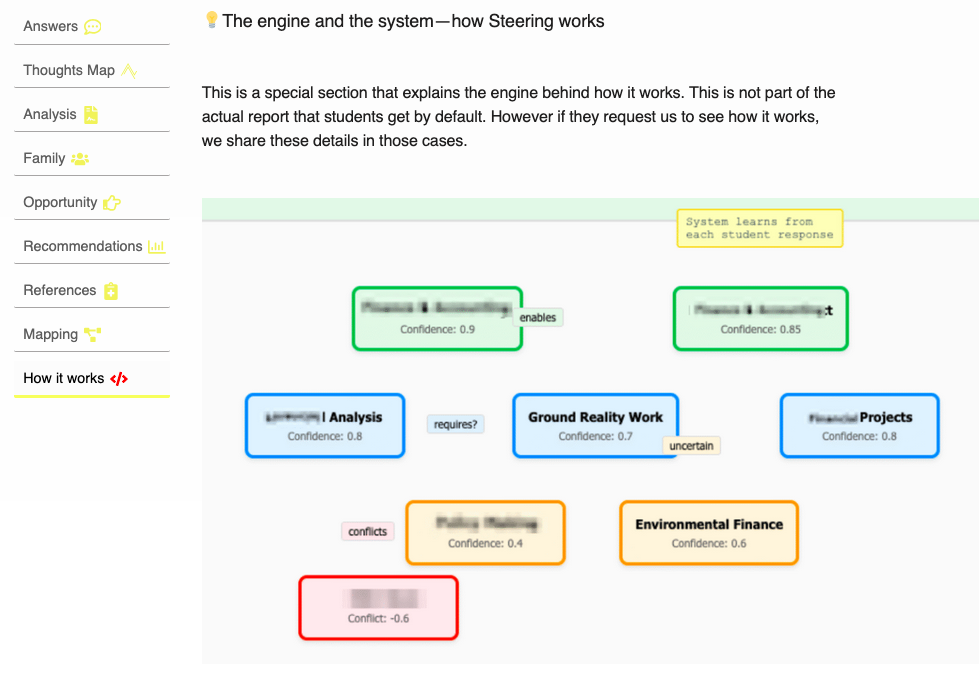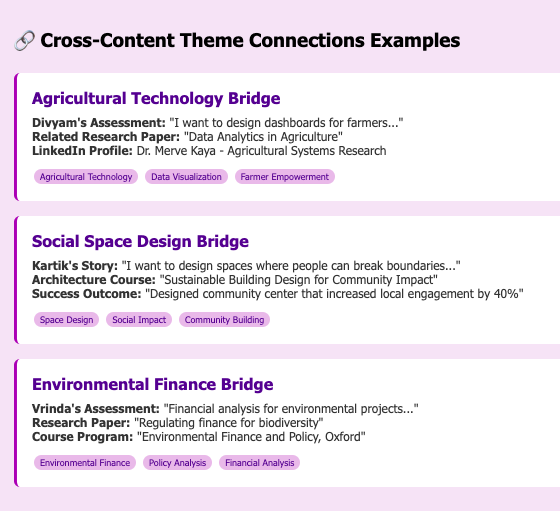IT professionals parents’ confusion for daughter’s college—The Steering advantage
- career choices
- August 14, 2025
The choices make it a complicated decision
Amit: Our daughter Priya is in 10th now we’re not sure about her next college.
Kavita: She’s a good student, scoring 90% but we all are including Priya are not sure. She often says that we as parents should guide her. We know computer science and we are confused between science and commerce. Commerce because we think there are ample opportunities in finance also.
Priya: [sitting quietly, occasionally looking at her phone] I really don’t have strong feelings either way.
Vinish: I am not surprised because this is so common. And if you think it from another perspective, it is better than a student who’s absolutely certain about something they don’t fully understand. At least Priya is honest about not knowing.
Vinish adds: Also, since she is not just defaulting to your field shows that she is thinking by her own, only that there are no clear decision models in the family.
Kavita: But how do we help her make such an important decision when she does not have a preference?
Amit: We keep thinking—we can guide her in computer science but it can also mean that we are imposing our choice on her.
Vinish: Can I ask—have you ever spoken about what kind of environment Priya enjoys, what excites her in the world, or when you are traveling, in public places, or even at home?
Priya: Not really. I mean, I like solving puzzles and I’m okay with Maths and Science both.
Vinish: Priya, when were in school, would you prefer working alone or in groups? And do you like working on data or statistics, or more inclined towards some research or analysis, or art, or literature? Or something else?
Priya: I like understanding how things work. Like in physics, I enjoy the problem-solving part. I enjoyed it in the groups and also independently.
Kavita: See, she is a generalist? No preferences is the main issue here.
Vinish: Actually, what she just shared is quite insightful. Problem-solving, understanding systems. These are valuable inputs. That’s where a more systematic approach could help, for example Steering.
Vinish add: We do not start with knowing your interests, aptitude, or personality, and we do not conclude with statements such as “choose between computer science and finance.” We start by understanding Priya’s aspirations, her motivations, her worldwide view of things that she observes and understands, then see where those lead to as a career.
Amit: How does it work when the student or the family are not sure of any career choices?
Vinish: Sometimes it is an advantage because the family and the student start from scratch, without a bias. Steering have this detailed questionnaire that asks things like “what problems in the world or society or in friends’ groups, or at home bother you enough that you’d want to help solve them?” or “what does meaningful work look like when you grow up as an adult?”
Priya: [remarks] Those are even harder than “what do you want to study.”
Vinish: That’s the point. Sometimes students don’t have preferences about subjects because they haven’t connected subjects to actual life-dreams, aspirations, their wishes, and for the impact or satisfaction.
Amit: Can you give us an example—how it works?
Vinish: Sure. After Priya fills the form, we might discover that she is actually motivated by helping people make better decisions, or enjoys working with data, or she prefers behind-the-scenes analysis and not being the face of the company. Those insights could point to financial analysis, product strategy, user research, or data science—and some of these combine your own fields.
Vinish: Or we might find out that she is interested in how systems affect our lives, which could lead to fintech for payments, where she might be building financial technology solutions. It is not necessarily computer science nor pure finance, rather a hybrid that leverages both.
Amit: I am curious to know how detailed it gets? I guess it might be quite vague to be honest.
Vinish: We are very comprehensive, showing how Priya’s specific motivations connect to career paths, with real market data, salary ranges, growth projections, and specific universities and programs.
Vinish adds: Plus LinkedIn profiles of professionals already working in those fields by following the same or similar career path. So instead of wondering “what does a financial analyst actually do,” Priya could see day-in-the-life content from real people. Isn’t it interesting?
Priya: That would be helpful. I have no idea what such careers look like in real life.
Amit: How do you ensure the career suggestions are realistic?
Vinish: This is where our data-driven approach plays the most important role. Priya’s report includes employment statistics, hiring trends, salary trends, and even job market stability notes. It’s quite rigorous.
The other beautiful part in the analysis is that we address family concerns. If you’re worried about job security in certain fields, we provide comparative data. Like, “financial technology roles have 15% higher job security than traditional IT roles” or whatever the actual data shows.
Kavita: What’s the process, and how long does it take?
Vinish: About 2-3 weeks in total—including 2-3 interactions in stages. Priya completes a detailed questionnaire—it takes around 45 minutes of being thoughtful and focused while answering the questions. We analyse the responses and share another set of questions to connect the dots. After we share the report with you via PDF, you can check the report in your personalized dashboard, and add personal notes there, for example a checklist.
Finally, there is a one:one call with a consultant to discuss the report and to answer your questions.
There are different models from this moment—you can commit to quarterly checkin plans where we remain connected, do more analysis, and address the thoughts of career-change. Sometimes students’ interests evolve with time–we give them more chances to build their career towards their life-dreams.


Priya: This is very interesting. Have there been some students who have benefitted from the service?
Vinish: Our website has a collection of letters that the students have written to their loved ones.
Amit: What about the cost? This sounds like a premium service.
Vinish: For the beginners, it costs around ₹30,000-₹40,000 for the complete analysis. It might sound significant, but remember that you are planning for an investment of 20-30 lakh, or even 40-50 lakh.
Would you do it by guesswork? Isn’t it such a huge risk, considering that the rate of college dropout of career change in the college is all time high.
Kavita: If I think about it positively, this investment in Steering services is less than 0.2% of the total education cost.
Vinish: And for families like yours where both parents are in technology and software, there might be an unconscious bias toward that field. Since Steering has a self-learning and an intelligent engine, it gives Priya a totally independent and objective analysis of her own wishes and her lens to see the world and life. Isn’t it what you want?
(Since Vinish knows that both the parents are IT professionals, he quickly shares a short Guide that explains how Steering works, its domain model, intelligence scoring, theme clustering, and the engine.)
Priya: [interested now] Can I try it without committing to the full amount?
Vinish: Yes, you can. Just complete the questionnaire for free and see a preview of the analysis. The insights are blurred but you can see the structure and it gives you an idea of how it helps and then you decide to invest in the full report.
Vinish: In fact, just going through the questions will give you some good food for thought for internal discussions.
Kavita: I wonder what if the analysis shows that Priya should do something totally different—DNA, climate, or medicine?
Vinish: The report will have enough data and evidence to support such a proposal.
Priya: So, if it says that I should study something on the intersection of technology and finance, what does it mean?
Vinish: Fintech product management, quantitative analysis, security for financial services, algorithmic trading systems, financial data science—there are so many roles that combine both fields.
Vinish adds: And with your parents’ expertise in technology, plus strong analytical skills from finance study, you will have a unique advantages in such hybrid roles.
Amit: That’s quite appealing.
Kavita: What next after we get the report?
Vinish: We have quarterly check-ins during college and career pivot support if needed. So if Priya starts in one stream and later finds out that she wants to change or rethink, we help in that transition.
Vinish adds: It is unreasonable to expect the kids to be very sure of what they want to study or what kind of work they want to do as an adult. We need to have some margins and respect their choices within that flexibility, and of course by supporting the family dynamics.
Priya: This sounds so good than just picking between two options.
Vinish: Yes, and all of you can see the website steeringhq.com. There are a few blog posts that resonate with your current situation, and a couple of guides to build your confidence in their methodology and their vision.
Kavita: Can Priya start with the questionnaire this weekend?
Priya: Yeah, I would like to try it.
Vinish: Certainly. And please remember that the goal is not to find the “perfect” career. It is to help Priya connect the dots, and find the convergence among the family members’ opinions, concerns, and preferences.
Amit: Thank you Vinish. This gives us a much more methodical approach than just debating between our two or three options.
Vinish: My pleasure. And Priya’s honesty about not knowing is actually a strength. You are just starting from a totally neutral perspective.
For students and families
The Steering advantage—how it brings a long-term and a holistic perspective in how you discuss careers and life at home.
Our design and product sense
Steering is designed around our domain-intelligence driven design engineering.
We have a free trial for you.
Our analysis structure in the free plan helps you in thinking deeply about your life-dreams, aspirations, wishes, and in connecting the dots for what you want to do, what skills you should learn, how to apply those skills in real life work, and what brings joy in your life when you grow up.
Steering is open for private access at present. You can take the free trial to get started.